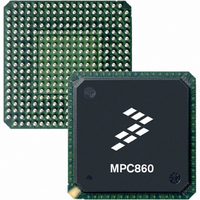MPC859DSLZP66A Freescale Semiconductor, MPC859DSLZP66A Datasheet - Page 12

MPC859DSLZP66A
Manufacturer Part Number
MPC859DSLZP66A
Description
IC MPU POWERQUICC 66MHZ 357PBGA
Manufacturer
Freescale Semiconductor
Datasheet
1.MPC859DSLCVR50A.pdf
(96 pages)
Specifications of MPC859DSLZP66A
Processor Type
MPC8xx PowerQUICC 32-Bit
Speed
66MHz
Voltage
1.8V
Mounting Type
Surface Mount
Package / Case
357-PBGA
Lead Free Status / RoHS Status
Contains lead / RoHS non-compliant
Features
-
Available stocks
Company
Part Number
Manufacturer
Quantity
Price
Company:
Part Number:
MPC859DSLZP66A
Manufacturer:
MOTOLOLA
Quantity:
513
Company:
Part Number:
MPC859DSLZP66A
Manufacturer:
Freescale Semiconductor
Quantity:
10 000
Thermal Calculation and Measurement
7
For the following discussions, P
The VDDSYN power dissipation is negligible.
7.1
An estimation of the chip junction temperature, T
where:
The junction-to-ambient thermal resistance is an industry standard value that provides a quick and easy estimation
of thermal performance. However, the answer is only an estimate; test cases have demonstrated that errors of a factor
of two (in the quantity T
7.2
Historically, the thermal resistance has frequently been expressed as the sum of a junction-to-case thermal resistance
and a case-to-ambient thermal resistance:
where:
R
case-to-ambient thermal resistance, R
heat sink, change the mounting arrangement on the printed-circuit board, or change the thermal dissipation on the
printed-circuit board surrounding the device. This thermal model is most useful for ceramic packages with heat sinks
where some 90% of the heat flows through the case and the heat sink to the ambient environment. For most
packages, a better model is required.
7.3
A simple package thermal model that has demonstrated reasonable accuracy (about 20%) is a two-resistor model
consisting of a junction-to-board and a junction-to-case thermal resistance. The junction-to-case covers the situation
where a heat sink is used or where a substantial amount of heat is dissipated from the top of the package. The
junction-to-board thermal resistance describes the thermal performance when most of the heat is conducted to the
printed-circuit board. It has been observed that the thermal performance of most plastic packages and especially
PBGA packages is strongly dependent on the board temperature; see
12
θJC
is device related and cannot be influenced by the user. The user adjusts the thermal environment to affect the
Thermal Calculation and Measurement
T
R
Estimation with Junction-to-Ambient Thermal Resistance
Estimation with Junction-to-Case Thermal Resistance
Estimation with Junction-to-Board Thermal Resistance
J
θJA
= T
T
R
P
R
R
R
A
D
= R
θJA
θJA
θJC
θCA
A
= ambient temperature (ºC)
= power dissipation in package
+(R
θJC
= junction-to-case thermal resistance (ºC/W)
= package junction-to-ambient thermal resistance (ºC/W)
= junction-to-ambient thermal resistance (ºC/W)
= case-to-ambient thermal resistance (ºC/W)
θJA
+ R
x P
J
θCA
-T
A
D
) are possible.
)
D
MPC866/MPC859 Hardware Specifications, Rev. 2
= (VDDL x IDDL) + PI/O, where PI/O is the power dissipation of the I/O drivers.
θCA
. For instance, the user can change the airflow around the device, add a
J
, in °C can be obtained from the equation:
Figure
3.
Freescale Semiconductor











